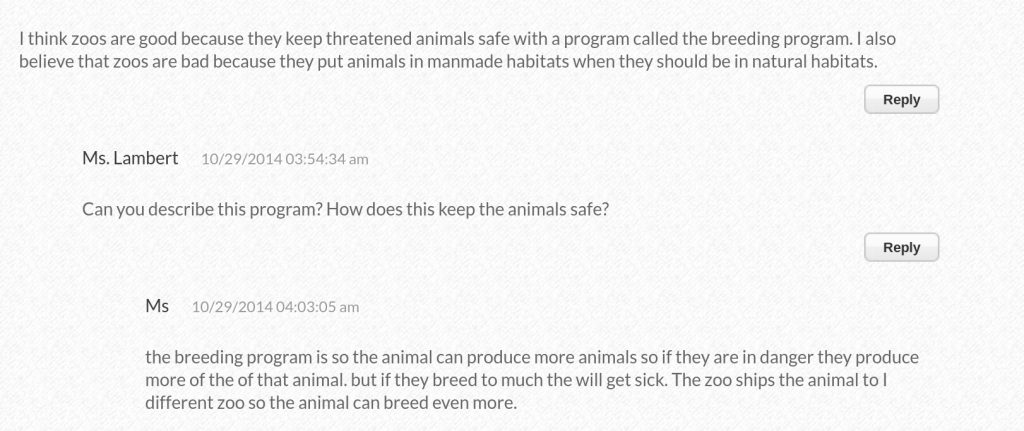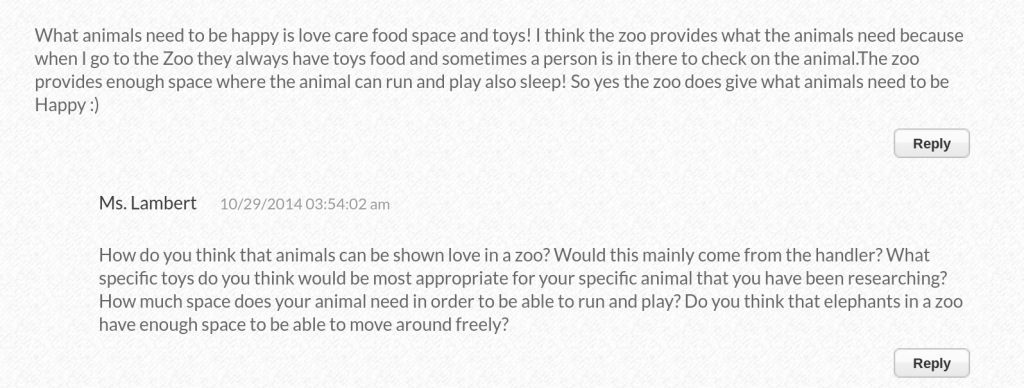The pandemic has changed the ways in which we can explore the world around us. Rather than being able to sign up to go on a field trip, many educators are opting for virtual field trips. With so many options out there, how might we ensure that we use these opportunities to connect it back to the learning in the classroom and to life in general? I ask this because I’ve been guilty of giving students these links to get them to simply explore but I wonder if there is more that we might do with these incredible opportunities. In this post, I’ll share a few ideas that I have.
Zoos & Aquariums
The San Diego Zoo and Ripley’s Aquarium are 2 sites for virtual field trips related to zoos and aquariums. I have to admit, these creatures are amazing to look at and I think it’s incredible that we have the opportunity to watch them live.
While watching, it got me thinking about a debate we had in class several years ago about zoos. After researching a variety of animal habitats, we used found materials to create our own zoo of sorts in our classroom. Students were tasked with determining what conditions needed for their animal of choice to survive and to build their habitat. Once all of the habitats were created, we organized the animals into areas that we thought made sense based on their needs. It was pretty cool and it led us to start talking about animals in their real habitats and in zoos.
We researched and discussed differing opinions and feelings about zoos.
A zoo supporter might say:
- The zoo is a fantastic place to learn about and see animals from different parts of the world.
- Zoos help to keep animals safe so that they don’t become in danger of extinction.
- Zoos help to take care of animals who may become sick. In the wild, these sick animals may die.
- Because of pollution and deforestation, animals are having a hard time finding food. Animals in zoos are well fed and taken care of.
Someone who is against zoos may say:
- Zoos don’t teach us much about animals because the animals there don’t act the way they would in the forest, jungle, or ocean, where they belong. We can learn more about animals by reading books or watching wildlife programs on TV.
- Animals are not happy in zoos. They want to be free to walk, run, fly, climb, hunt, and have families. There simply isn’t enough room for them in the habitats that are created at the zoo.
- When a zoo doesn’t want an animal anymore, the animal gets killed or sold to another zoo and might have to travel far away by boat, truck, or plane.
After sharing these ideas, students were asked to reflect on a couple of questions, and as a part of our classroom blog, they shared their thoughts and debated their points with their peers. The questions were:
- What kinds of things do animals need to be happy? Do you think animals in zoos get all these things? Why or why not?
- Think about the animals you’ve seen at the zoo. Do you think there is somewhere else they would rather be? Something else they would rather be doing? Why or why not?
- Do you support zoos? Why or why not?
There was a lot of healthy debate going back and forth as students justified their answers about whether or not they supported zoos.

Not only might heading on these virtual field trips be a great way for students to see animals they may not have seen before, but it may also be a great start to conversations around the need for zoos and aquariums and the ethics behind them.
Museums & Art
Art has always been of interest to me. From studying Art from a particular part of the world to understanding how art is connected to culture, so much can be said by looking at a painting or sculpture. Here are a few sites that I’ve explored with students:
- Christi Belcourt – Christi Belcourt is a Métis artist with a deep respect for Mother Earth, the traditions, and the knowledge of her people. In addition to her paintings, she is known as an environmentalist and advocate for the lands, waters, and Indigenous peoples
- Tomb of Menna – Located in Luxor, the tomb of Menna is known for the colorful and well-preserved paintings that adorn the chapel walls.
- The Canadian Museum of History – The mandate of the museum is “to enhance Canadians’ knowledge, understanding and appreciation of events, experiences, people, and objects that reflect and have shaped Canada’s history and identity, and also to enhance their awareness of world history and cultures.”
- The Royal Tyrrell Museum of Palaeontology – Canada’s only museum dedicated exclusively to the study of ancient life.
- The Aga Khan Museum – The Aga Khan Museum presents and collects art from historically significant Muslim civilizations as well as contemporary Muslim communities and diasporas around the world.
When exploring museums and art, I’ve asked students to reflect on pieces that stand out to them and to explain why they were of particular interest. I’ve also had students consider the elements of art – line, shape, texture, form, space, colour, and value – and how the artist used the elements to evoke particular emotions or feelings. I also tend to ask students if there is a particular style that they can attribute to the artists and consider learning more about their particular style. I’ve mentioned before that art is connected to culture. Perhaps posing a question such as, “Is art shaped by culture or is culture shaped by art?”, might spark meaningful conversations around the connection between the two.
Science
Ok…zoos and aquariums fit under this category too. Here are a couple of virtual field trips that my students enjoyed related to physical and earth sciences.
- Slime in Space – This is a 15-minute virtual field trip to outer space to see how slime, and water, react in a microgravity environment.
- Hawaii’s Volcanoes – Take a trip back in time to explore the land shaped by the world’s most active volcanoes.
Everyone loves slime. Ok…well…maybe not everyone. I’ll admit. I’m not a fan. When I stumbled upon the link to Slime in Space, it got me thinking about the time I had a student teach the class how to make slime. It was an opportunity to see the connection between procedural writing for a science experiment and an exercise in problem-solving when it didn’t quite work out. It was an experiment based on the student’s interest and it was amazing to watch them lead their peers with great enthusiasm. When thinking about student interest, last year I had a student who was so fascinated by natural disasters and when it came to exploring Hawaii’s volcanoes, he was all in. This interactive adventure allowed him to learn more about volcanoes and understand how the land was formed in a way that was more real than reading it in a book. How else might we bring student interest into the classroom through these virtual opportunities?
The world is changing and it seems as though virtual field trips are a way to still connect us to the greater world around us. By no means is this an extensive list of what is out there in terms of virtual field trips. Hopefully, this gives you some ideas of how they can be used in the classrooms with students. Have other ideas to share? Please feel free to add them in the comments below!


